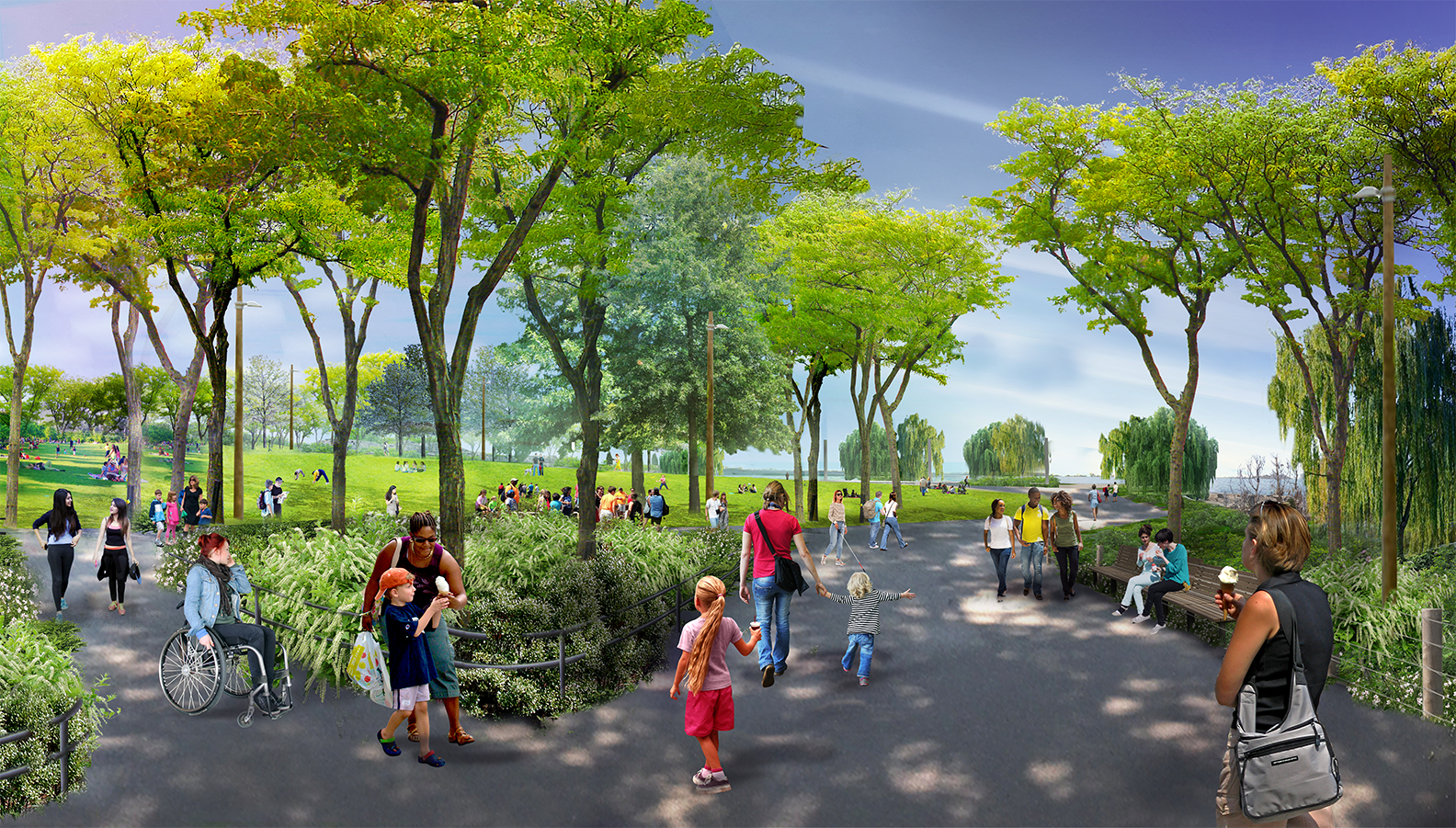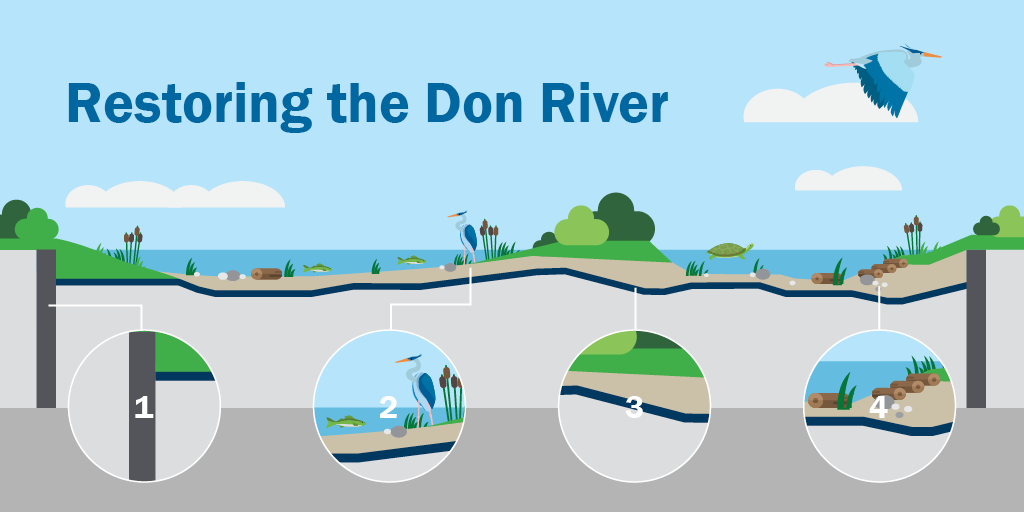Call to Indigenous Designers, Artists and Architects
Request for Prequalification: Original Designs for Park Features at the Mouth of the Don River
Waterfront Toronto is seeking Indigenous architects, designers and artists to create a series of features in the new mouth of the Don River. The features will reflect and celebrate local Indigenous culture and the significance of the Don River Valley to Indigenous people.
The new mouth for the Don is now under construction as part of the Port Lands Flood Protection project. Learn more about the overall project.

About the Request for Prequalification (RFP)
This Prequalification is the first stage in a two-stage process. Waterfront Toronto invites Indigenous architects, artists and/or designers or artist/designer teams to submit their qualifications. A small number of applicants will then be shortlisted to proceed to the second stage and submit a proposal for the design of integrated features within the future parks at the mouth of the Don River. Learn more about the selection process below.
Waterfront Toronto is seeking creative and talented collaborators who can work with the Port Lands Flood Protection (PLFP) project team to develop designs that can be successfully integrated into existing plans. Five specific park features will be commissioned through this process.
- Fire Holder Feature
A fire holder in the west gathering space in Promontory Park South is intended for public use. The space will also be used for ceremony involving fire and water. A narrative for the fire holder can include graphics, text, materiality, colour, etc.
- Ceremony and Celebration Shade Structure
A covered, open-air structure will provide shade and rain protection for celebrations and ceremony. The structure may also be used by visitors to the park for meeting and gathering. It should be inclusive of all visitors and a variety of activities year-round.
The applicants for this park feature must include an architect registered and licensed to practice in Ontario.
- Indigenous Teaching Signifiers
A series of cultural markers will be integrated into the landscape in multiple locations. These signifiers should reflect the unique culturally significant attributes of the site. The intention is to introduce permanent, robust, designed elements that could include language, light, symbols, carvings, or signs that can be interpretive or educational.
- Interpretive Signage Design and Illustration
A series of interpretative and wayfinding signs, illustrations, or markers will reflect the Indigenous history and presence at the site. They will also reflect the naturalization and reclamation of the mouth of the Don River.
- Directional Orientation Compasses
Orientation compasses embedded in the ground at major entry points within the park site will situate visitors in relation to Indigenous knowledge and understandings of place, location, direction and time.
Issue Prequalification: August 25, 2022
Briefing Session: September 15, 2022 at 6:30 p.m.
Recommended Deadline for Questions: October 3, 2022
Submission Deadline: October 13, 2022 at 4 p.m. (local time)
Indigenous architects, designers, and/or artists, born or living in Canada, are eligible. Recognition as an Indigenous person by the Indigenous community and ability to demonstrate learnings from their own journey and teachings received are important.
Applicants must be Indigenous artists or designers (e.g. graphic designers, industrial designers, sculptors, visual artists, text-based artists, sound artists, architects) with a history of commissions for their creative work, a background including specialized training (academic or traditional) in design or visual art, and community or peer recognition as a professional designer or artist.
Indigenous Engagement in the Port Lands Flood Protection Project
For thousands of years, the mouth of the river now known as the Don River was a fertile wetland, fishing ground, and important gathering place for Indigenous people who lived in the region. The mouth of the Don River is within the Treaty and Traditional Territory of the Mississaugas of the Credit First Nation (MCFN) and was also historically used by many other Indigenous people including the Anishinaabe, Haudenosaunee, and Huron Wendat peoples.
The rivers, lakes and waterways were a vital connection to Indigenous communities and peoples traveling throughout the Great Lakes region. Toronto and the surrounding area remains home to a large, vibrant and diverse Indigenous community.
In the early 1900s, Toronto filled in the Ashbridges Bay marsh, now known as the Port Lands, to make space for a growing industrial port and redirected the Don River with an unnatural ninety-degree turn down the concrete-lined Keating Channel. This history of settlement and lake-filling at the mouth of the Don River is a story of the damage of colonialism, expansionism, and disregard for land, water, and life.
Waterfront Toronto, with funding from the federal, provincial and municipal governments, is now in the process of reinstating a naturalized river mouth for the Don River as part of the $1.25-billion Port Lands Flood Protection Project (PLFP). The project will create a new island in the harbour’s archipelago, establish a new river valley with functional wetlands, and deliver 25 hectares of publicly accessible open space along the riverbanks and inner harbour. The goals of cleaning and restoring contaminated soils and naturally accommodating the effects of flooding and erosion will be complemented by re-establishing aquatic and terrestrial habitat where Indigenous species of plants and animals can thrive.
More than building a river mouth, the project team is building relationships with Indigenous partners and consultants as they design and construct public space together. This massive project aims to be an act of reconciliation and healing; that is reflected in the experience of nurturing the new river valley and in establishing inclusive relationships with the land and the community for future generations.
In a collaborative process with MinoKamik Collective and MCFN, the design team has met with Elders and representatives from the original environmental assessment including: Alderville, Beausoleil, Curve Lake, Chippewas of Georgina Island and Rama, Hiawatha, and Scugog First Nations, Mississaugas of the Credit, Huron Wendat, Toronto York Métis Council, and other urban Indigenous organizations in Toronto.
In these meetings, the team heard that the restoration of the mouth of the Don River and the creation of new parks and open spaces offers the opportunity to showcase Indigenous histories, resilience, and interconnectedness to the natural environment. They also heard that the new parks and river mouth should highlight local Anishinaabe traditions, stories and culture. The restoration of habitat and the cultivation and stewardship of Indigenous plants, and particularly traditional medicines, was of great importance to the participants.
More Information
In order to apply, you must request and receive the full copy of the Request for Prequalification by email.
Please email Waterfront Toronto Procurement to request a copy.
While every effort will be made to update this website, only the full copy of the Request for Prequalification document and any addenda that are issued by email can be considered authoritative. In order to receive up-to-date information and clarifications, applicants must request the full document by email.
Submissions must be submitted electronically via email to Procurement on or before the deadline.
An optional briefing session will be held virtually on September 15, at 6:30 pm. If you plan to attend this briefing session, please notify Waterfront Toronto immediately by email at Waterfront Toronto Procurement. Details on how to connect will be provided ahead of time. In the subject line, include the opportunity title and reference number as follows:
Indigenous Architecture, Design, Art – Prequalification #2022-14
If there are any questions about submission, they should be asked in advance of the Recommended Deadline for Questions via email to Procurement.
Simple administrative questions may be answered directly. All other questions, including those asked at the briefing session, will be circulated with their answers to all applicants.
This Prequalification is the first stage in a two-stage process to commission the design of integrated features within the landscape of three future parks and valley lands at the mouth of the Don River.
Stage One: Request for Qualifications
Waterfront Toronto invites Indigenous architects, artists and/or designers or artist/designer teams to submit their qualifications. Submissions should include all the required documents outlined in the Request for Prequalification document. Designers/artists may indicate their interest to be considered for one or more of the opportunities included in the procurement.
Stage Two: Request for Proposals
A small number of applicants will be shortlisted for each of the park features and invited to submit a proposal. The successful applicants will be responsible for creating a comprehensive design that is anticipated to include:
- illustrations of the concept,
- precise locations,
- dimensions, details and specifications for construction,
- materials and production methods, and
- a detailed budget for the execution/construction of the feature.
One applicant will be selected for each of the park features. It is possible that one applicant may be selected for more than one opportunity.
About the Port Lands
Explore this website to learn more about different aspects of the Port Lands Flood Protection Project. Here are a few useful links to get you started:
- Interactive Map (works best on a desktop)
- Why This Matters
- Frequently Asked Questions
- Nature and Parks in the Port Lands
This video also gives a good overview of what we’re building and why:
Construction is progressing quickly. We’ve excavated more than 400,000 cubic metres of soil from the future river valley. This video shows a drone flight over the site from May. It identifies points of interest and major streets of the future Villiers Island.
How are we restoring the Don River’s natural flood-protection capacity?
- Stabilizing perimeter walls
- Adaptive landscapes
- A barrier to protect the river
- Foundations for a thriving ecosystem, such as plantings to create habitat